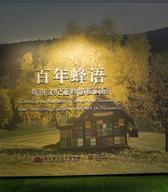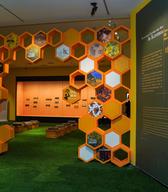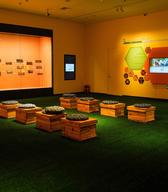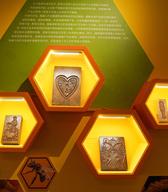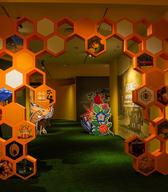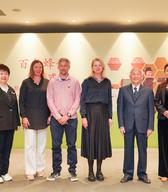Beekeeping Culture and Art of Slovenia
Between October 2024 and March 2025, the Slovene Ethnographic Museum is visiting China in the famous Xi'an Qujiang Museum of Fine Arts, Shaanxi Province, with the exhibition Bee Culture and Art of Slovenia.
With a selection of objects and texts, curators Dr. Bojana Rogelj Škafar and Barbara Sosič from SEM present Slovenia to the Chinese public as the homeland of the native Carniolan bee and its skilled beekeepers, who uphold a centuries-old tradition. The exhibition highlights folk art not only as a reflection of beekeeping culture but also as an integral part of life for much of the Slovenian population in the 19th century. Through authentic objects, it shows the remarkable and unique creativity found on Slovenian soil, bringing Slovenia's exceptional cultural heritage closer to the Chinese audience.
As the co-author of the exhibition, Barbara Sosič, wrote, »For the Slovenes, beekeeping is the poetry of agriculture." The autochthonous Carniola bee plays an important role in this, which today is the second most widespread bee species in the world due to its many exceptional properties. Bees have always been valued for their honey and wax, but today we realize that as pollinators they are crucial to food production. In addition to their economic and agricultural importance, they have a high symbolic meaning for many nations, especially the Slovenes, as the bees found their way into art and social culture.
In Slovenia, a high level of beekeeping knowledge and values is passed down from generation to generation in families and beekeeping societies. Today, we have around 11,000 beekeepers in Slovenia, which is the largest number of beekeepers per population in Europe.
On the initiative of Slovenia, May 20 has been declared World Bee Day, beekeeping has been included into the national Register of Intangible Cultural Heritage since 2018. Beekeeping in Slovenia as a way of life was included into the UNESCO Representative List of the Intangible Cultural Heritage of Humanity (2022).
Among other objects, the AŽ hive will be on display at the exhibition. It is considered a "Slovenian brand" as it is used by more than 90% of Slovenian and other beekeepers around the world. At the turn of the 20th century, several imported and domestic types of hives were in use in Slovenia, but none of them fully met the needs of Slovenian beekeeping. This changed in 1910, when the chief beekeeper Anton Žnideršič (1874–1947) presented a new invention to the public: the AŽ hive. The hive was largely accepted, as it is perfectly adapted to Slovenian traditional beekeeping in apiaries, allows easy transportation to different pastures, provides excellent conditions for the Carniolan bees to thrive, makes the work of beekeepers easier, and enables the production of high-quality honey and wax.
According to the exhibition curator, Dr. Bojana Rogelj Škafar, Slovenia is represented in China with its original art form—the beehive panels with many religious and secular images from everyday life. These began to appear in the second half of the 18th century. They are a unique feature of Slovenian cultural heritage. The Slovenian Ethnographic Museum houses the largest collection in the country, including more than 770 beehive panels, 60 of which are displayed in Xi'an.
The appearance of apiaries typical of Slovenia dates back to the second half of the 17th century, when they were wooden huts with an open front and a roof that protected the bees from the sun and rain. The hives were placed one above the other in the apiary. After 1857, the front side of these beehives (called kranjič in Carniola) was given a painted front board—a beehive panel. These paintings are the original genre of folk art and the only art genre with many secular and figural motifs as well as moralistic and satirical content.
They were painted by simple, self-taught painters who sourced the motifs from religious images, illustrated German Bibles, graphics, newspaper and book illustrations, and often as fruit of their own imagination. Most of the motifs are figural, among them more than 600 different ones, of which half are religious motifs, depicting scenes from the Old and New Testaments, legends of saints, and images of saints. From the middle of the 18th century until the First World War, over 50,000 panels were painted.
The most attractive secular motifs are animals in human roles, the mockery and weaknesses of women, tailors, and shoemakers, pub scenes, military and exotic motifs, and scenes relating to the relationship between genders, which attract the most attention. The painting genre developed a special painting style and is also the richest European collection of paintings with figural motifs in the lower social classes. The painted beehive panels are therefore valuable witnesses of the cultural needs, worldviews, and creative energy of the farming population.




